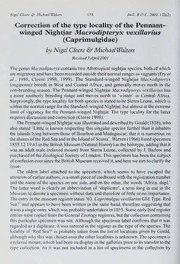Table Of Content&
Nigel Cleere MichaelWalters 158 Bull. B.O.C. 2002 122(2)
Correction of the type locality of the Pennant-
winged Nightjar Macrodipteryx vexillarius
(Caprimulgidae)
&
by Nigel Cleere MichaelWalters
Received7April2001
The genusMacrodipteryxcontainstwoAfrotropicalnightjarspecies, bothofwhich
aremigratoryandhavebeenrecordedoutsidetheirnormalrangesasvagrants(Fryet
al, 1988, Cleere 1998, 1999). The Standard-winged Nightjar Macrodipteryx
longipennis breeds in West and Central Africa, and generally moves north in the
non-breeding season. The Pennant-winged NightjarMacrodipteryx vexillarius has
a more southerly breeding range and moves north to 'winter' in Central Africa.
Surprisingly, the type locality forboth species is statedto be SierraLeone, whichis
withinthenormalrangeforthe Standard-wingedNightjar,butalmostattheextreme
limit ofvagrancy for the Pennant-winged Nightjar. The type locality for the latter
requiresdiscussionandcorrection(Cleere 1998).
ThePennant-wingedNightjarwasillustratedanddescribedbyGould(1838),who
also stated 'Little is known respecting this singular species further than it inhabits
the islands lyingbetweenthose ofBourbon andMadagascar; that it is numerous on
theshoresoftheRedSeaandintheIslandofScutra'.Warren(1966)listedspecimen
1855.12.19.63 intheBritishMuseum(NaturalHistory)astheholotype,addingthatit
was an adult male (relaxed mount) from Sierra Leone, collected by J. Barlow and
purchasedoftheZoological SocietyofLondon. This specimenhasbeenthe subject
ofconfusioneversincetheBritishMuseumreceivedit,andhereweaimtoclarifythe
issue.
The oldest label attached to the specimen, which seems to have escaped the
attentionofearlierauthors,isasmallpieceofcardboardwiththeregistrationnumber
and the name ofthe species on one side, and on the other, the words 'Africa, dupl.'
The latter word is clearly an abbreviation of 'duplicate', a term long in use in the
Museumto denote a specimenwithoutdataandtherefore oflittle orno importance.
Theentryinthemuseumregisterstates '63. CaprimulgusvexillariusGld.Type. Red
Sea?' and appears to have been written in the same hand, therefore suggesting that
itwasasingleentrywhichwasprobablyundertakenin 1855. Someearlybirdregister
entrieswerecopiedfromtheGeneralZoologyregisters,butthecollectioncontaining
this particular specimen was not. Although the specimen label confirms that itwas
regarded as aduplicate, itwas entered inthe registeras the type ofthe species. The
locality of'Red Sea?' is probably taken from the list oflocations given by Gould,
although whythis waschosenovertheotherlocalities isunknown. The specimenis
arelaxedmount,whichhadbeenondisplayinthegalleriespriortoitstransfertothe
type collection. As it was not included in a list of specimens in the collection by
&
Nigel Cleere MichaelWalters 159 Bull. B.O.C. 2002 122(2)
Hartert(1892),itwaspresumablyremovedfromthegallerysometimeafterthen,but
theprecisetimeofitsremoval isunknown.
The second label on the skin is the one that has been quoted and discussed, and
was evidently added afterthe specimen was removed from the gallery. The data on
this label, which were supposedly copied from beneath the stand ofthe mounted
specimen, state 'Jas. BarlowEsq., SierraLeone. Orig. descr. J. GouldEsq.,underthe
nameofCaprimulgusvexilla'. Followingvexillaisanalmostillegibleword 'Lirg' or
'Ling'whichlooksasifitwasintendedtobethenameofanauthor,althoughSherborn
(1922) indicates thatno taxon ofanybirdhas everbeen describedwiththe specific
namevexilla.
This specimenanditscollectionlocalitywereeventuallydiscussedby Sclater&
Mackworth-Praed(1919,p. 659footnote).Theydrewattentiontotheinformationon
the secondMuseum label, whichthey interpretedas meaningthatthe specimenhad
beencollected in SierraLeone, and sawno reasonwhy it shouldnotbe accepted as
the type ofthe species and the locality accepted as the type locality. However, even
acceptingthetranscribedinformationonthe label as correct, there isno evidenceto
linkthe specimentoGould. 'Orig. descr. J. GouldEsq.'ismoreplausiblyinterpreted
as meaningthatGould first describedthe species, butnotthathe did so onthebasis
of this specimen; we have no evidence that it was ever in his possession. The
identity of 'Jas. Barlow' has eluded our investigations, as nobody of this name
appearsinanybiographical sourceavailabletous. Itisnotpossible,therefore,tosay
withanycertaintythattheascriptiononthelabellinkinghisnamewiththatofSierra
Leonemeansthatthespecimenoriginatedthere. Manyearlyspecimensareknownto
havebeenmislabelled, ortohavebeenobtainedfromalocationdifferentfromtheir
countryoforigin.
The type locality ofSierra Leone forthe Pennant-wingedNightjarhas certainly
createdproblemsforsubsequentauthors.Bannerman(1933)stated 'Itisalsorecorded
from Sierra Leone but doubt has been cast on this record', whilst Peters (1940) and
&
Fryetal (1988)simplyfollowedSclater Mackworth-Praed(1919)inquotingSierra
Leoneasthetype locality.ThatBarlow's specimenoriginatedin SierraLeone seems
increasinglyunlikely. HadGouldhadaspecimenfromthiscountryinfrontofhim, it
isinconceivablethathewouldnothavementionedthisinhisdescription. Evenmore
significantly, he stated 'the general structure ofthis species is preciselythe same as
that ofthe Macrodipteryx africanus, Swains, and it doubtless represents that bird
on the opposite side ofthe African continent'. The range for M. africanus (= M.
longipennis) was described by Swainson (1837) as West Africa, and we do not
believethatGouldwouldhave saidhisnew speciesoccurredontheopposite side of
the continent ifhis only specimen also came fromWestAfrica.
We conclude from the foregoing that there is no evidence to support the view
that Barlow's specimen is the type of Macrodipteryx vexillarius, or that Barlow
actuallycollectedhis specimen in SierraLeone. Barlowmaynotevenhavebeenthe
collector; hemaymerelyhaveownedthe specimen.Webelievethatthewhereabouts
ofthe specimen illustrated and described by Gould remains unknown and possibly
&
Nigel Cleere MichaelWalters 160 Bull. B.O.C. 2002 122(2)
no longer exists. It is unclearwhy Gould gave the range forthis nightjar as islands
between Bourbon (=Reunion) and Madagascar, the shores ofthe Red Sea and the
IslandofScutra (=Socotra ?), as itdoes notappearto havebeenrecordedanywhere
inthoseareas. ThebirddepictedanddescribedbyGouldwasanadultmalewithfull
pennantsandwasprobablyabreedingbird. Thepost-breedingmoultofthis species
suggests thatbirds in this plumage are unlikely to be found at the extreme limits of
vagrancy(Cleere 1998). Intheabsenceofavalidtypespecimen,wesuggest'southern
Africa' as an acceptable type locality forMacrodipteryx vexillarius.
Acknowledgements
We would like to thank Michael Stuart Irwin, who originally brought to our attention the
anomalyofthetypelocalityforthePennant-wingedNightjar.WearealsoindebtedtoRobertPrys-Jones
andBobDowsett,whosecommentsgreatlyimprovedthemanuscript.
References:
Bannerman, D.A. 1933. The birds oftropical WestAfrica. Vol. 3. Crown Agents for the Colonies,
London.
Cleere, N. 1998. Nightjars. A guide to nightjars and related nightbirds. Pica Press, Sussex.
Cleere, N. 1999. Family Caprimulgidae (Nightjars). In : del Hoyo J., Elliott A. & Sargatal J. (eds)
Handbook ofthe birds ofthe world. Vol. 5. Lynx Edicions, Barcelona.
Fry, C.H., Keith, S. & Urban, E.K. 1988. The birds ofAfrica. Vol. 3. Academic Press, London.
Gould, J. 1838. Icones Avium. Pt. 2. J. Gould, London.
Hartert, E. 1892. Catalogue ofthe birds in the British Museum. Vol. 16. British Museum,
London.
Peters, J.L. 1940. Check-list ofbirds ofthe world. Vol. 4. Harvard Univ. Press, Cambridge, Mass.
Sclater, W.L. & Mackworth-Praed, C.W. 1919. A list ofthe birds ofthe Anglo-Egyptian Sudan,
based on the collections of Mr A.L.Butler, Mr A.Chapman and Capt. H.Lynes R.N., and
Major Cuthbert Christy R.A.M.C. (TF) pt. 3 Picidae - Sagittariidae. Ibis (11) 1: 628 - 707.
Sherborn, CD. 1922, Index Animalium. Trustees of the British Museum (Natural History),
London.
Swainson, W. 1837. On the natural history and classification ofbirds. Vol. 2. Longman, Brown,
Green & Longmans, London.
Warren, R.L.M. 1966. Type specimens ofbirds in the British Museum (Natural History). Vol. 1.
Non-Passerines. Trustees ofthe British Museum (Natural History), London.
Addresses: Nigel Cleere, 2 Hawthorn House, Roundfield, Upper Bucklebury, Berks, RG7 6RQ,
UK. E-mail [email protected]; Michael Walters, Bird Group, The Natural History
Museum, Tring, Herts, HP23 6AP, U.K. E-mail [email protected]
© British Ornithologists' Club 2002

